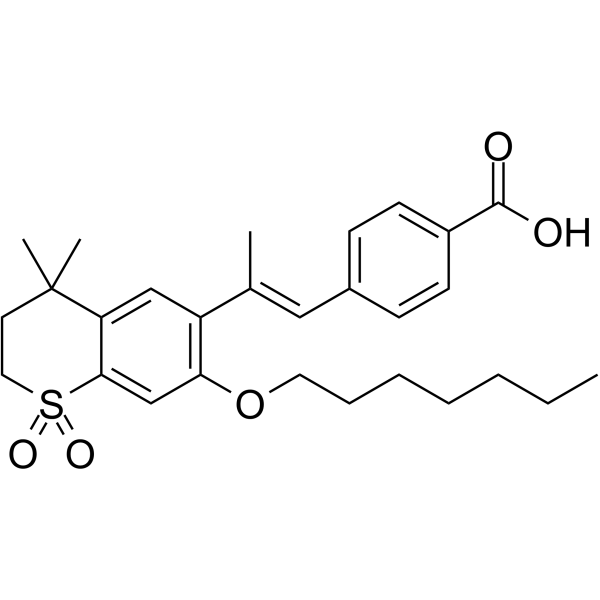| Description |
Ro 41-5253 is an orally active selective retinoic acid receptor alpha (RARα) antagonist. Ro 41-5253 can bind RARα without inducing transcription or affecting RAR/RXR heterodimerization and DNA binding. Ro 41-5253 can inhibit cancer cell proliferation and induce apoptosis, has antitumor activity[1][2].
|
| Related Catalog |
|
| Target |
IC50: 60 nM (RARα), 2.4 μM (RARβ), 3.3 μM (RARγ)[3].
|
| In Vitro |
Ro 41-5253 (1 nM-10 μM, 10 days) significantly inhibits MCF-7 and ZR 75.1 cell proliferation and induces cell apoptosis in a time and dose-dependent manner[1]. Cell Proliferation Assay[1] Cell Line: Human breast-carcinoma lines MCF-7 and ZR 75.1 Concentration: 1 nM-10 μM Incubation Time: 10 days Result: Inhibited 81% MCF-7 cell growth at 10 μM, 30% cell growth at 1 μM and no significant inhibitory effect at concentrations below 0.1 μM. Inhibited 74% ZR 75.1 cell growth at 10 μM, 63% cell growth at 1 μM and 42% cell growth at 0.1 μM. Apoptosis Analysis[1] Cell Line: Human breast-carcinoma lines MCF-7 and ZR 75.1 Concentration: 1 nM-10 μM Incubation Time: 10 days Result: Induced 28.5, 21.6, 16 and 12% of MCF-7 cells apoptosis at 10 μM, 1 μM, 0.1 μM and 0.01 μM respectively on the fourth day while induced 58, 51, 36 and 21% of cells apoptosis at 10 μM, 1 μM, 0.1 μM and 0.01 μM respectively after six days. Induced 80, 65, 43 and 29% of ZR 75.1 cells apoptosis at 10 μM, 1 μM, 0.1 μM and 0.01 μM respectively on the sixth day.
|
| In Vivo |
Ro 41-5253 (oral gavage, 10-600 mg/kg, once a week, 4 weeks) can reduce tumor volume in female athymic Balb/mice transplanted with MCF-7 cell line[2]. Animal Model: Six-week-old female athymic Balb/mice transplanted with MCF-7 cell line[2] Dosage: 10, 30, 100, 300 and 600 mg/kg Administration: Oral gavage; once a week; 4 weeks Result: Resulted in a reduction in tumor volume at doses of 10, 30 and 100 mg/kg with no toxic side effects.
|
| References |
[1]. S Toma, et al. RARalpha antagonist Ro 41-5253 inhibits proliferation and induces apoptosis in breast-cancer cell lines. Int J Cancer. 1998 Sep 25;78(1):86-94 [2]. Salvatore Toma, et al. Retinoids and human breast cancer: in vivo effects of an antagonist for RAR-alpha. Cancer Lett. 2005 Feb 28;219(1):27-31. doi: 10.1016/j.canlet.2004.06.018. [3]. C Apfel, et al. A retinoic acid receptor alpha antagonist selectively counteracts retinoic acid effects. Proc Natl Acad Sci U S A. 1992 Aug 1;89(15):7129-33.
|
